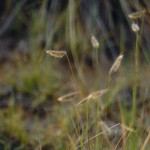Hairy Grama
Bouteloua hirsuta Lag.
Poaceae
Description
Hairy Grama’s common name references the stiff papilla-based hairs on its glumes. It is a very widespread species occurring throughout all Texas regions. Erect stems grow from a tufted base with four to six glabrous nodes. In the southern part of its Texas range, there tend to be two to four branches per seedhead. North of Texas, one to two branches are more common and tend to form sod, not clumps. The leaf blades are both basal and cauline, only 2 mm wide by 10 to 15 cm long, and hairy on the margins, especially at the leaf base where dark glandular-based hairs are found. The ligule is a short, ciliate membrane, and the collar is hairy. There are one to four spikes up to 4 cm that tends to be purplish before maturing and resemble rooster combs. The rachis projects beyond the spikelets forming a “stinger” of up to 1 cm. From their base, the branches bear 20 to 50 closely spaced spikelets. Hairy Grama is a perennial, warm-season, native reaching up to 20 inches or 50 cm tall that produces seed from June to November. Considered fair grazing for livestock and wildlife, it has high palatability late in the growing season, but livestock will graze on it in any season. It tends to increase with heavy grazing.Habitat
Grows on rocky hills and plains in a wide variety of well-drained soil types. Hairy Grama can withstand extreme drought, but it produces little forage in those conditions.Images
Plant Characteristics
Duration: Perennial
Stem Texture: Hairy
Growth Habit: Bunch grass, Grasses
Season: Warm
Distribution
 : 01 - Pineywoods, 02 - Gulf Prairies and Marshes, 03 - Post Oak Savannah, 04 - Blackland Prairies, 05 - Cross Timbers and Prairies, 06 - South Texas Plains, 07 - Edwards Plateau, 08 - Rolling Plains, 09 - High Plains, 10 - Trans-Pecos
: 01 - Pineywoods, 02 - Gulf Prairies and Marshes, 03 - Post Oak Savannah, 04 - Blackland Prairies, 05 - Cross Timbers and Prairies, 06 - South Texas Plains, 07 - Edwards Plateau, 08 - Rolling Plains, 09 - High Plains, 10 - Trans-Pecos
Distributions
Distribution refers to the ecological region in Texas that a plant has been found. You can also view a clickable map.
Book: Know Your Grasses (B-182)
Collection: Grasses



